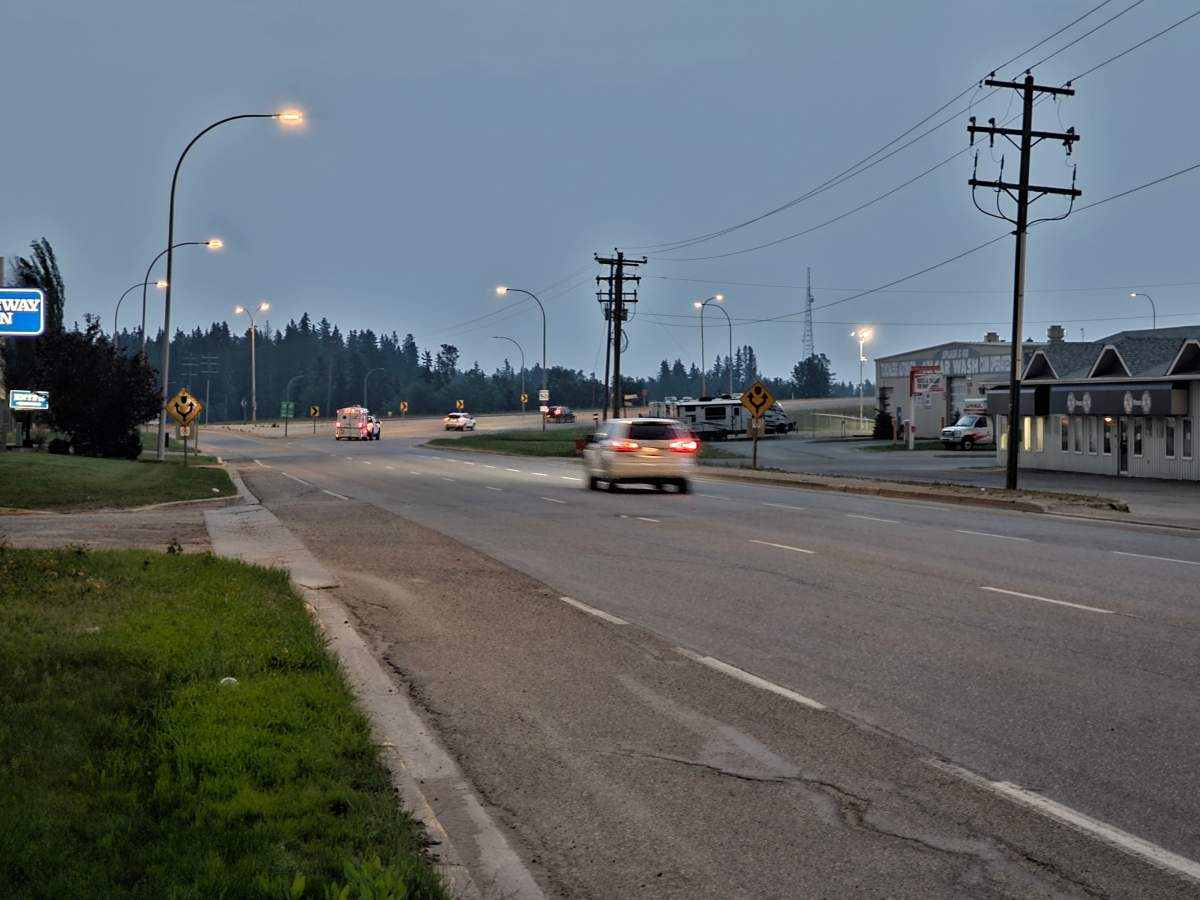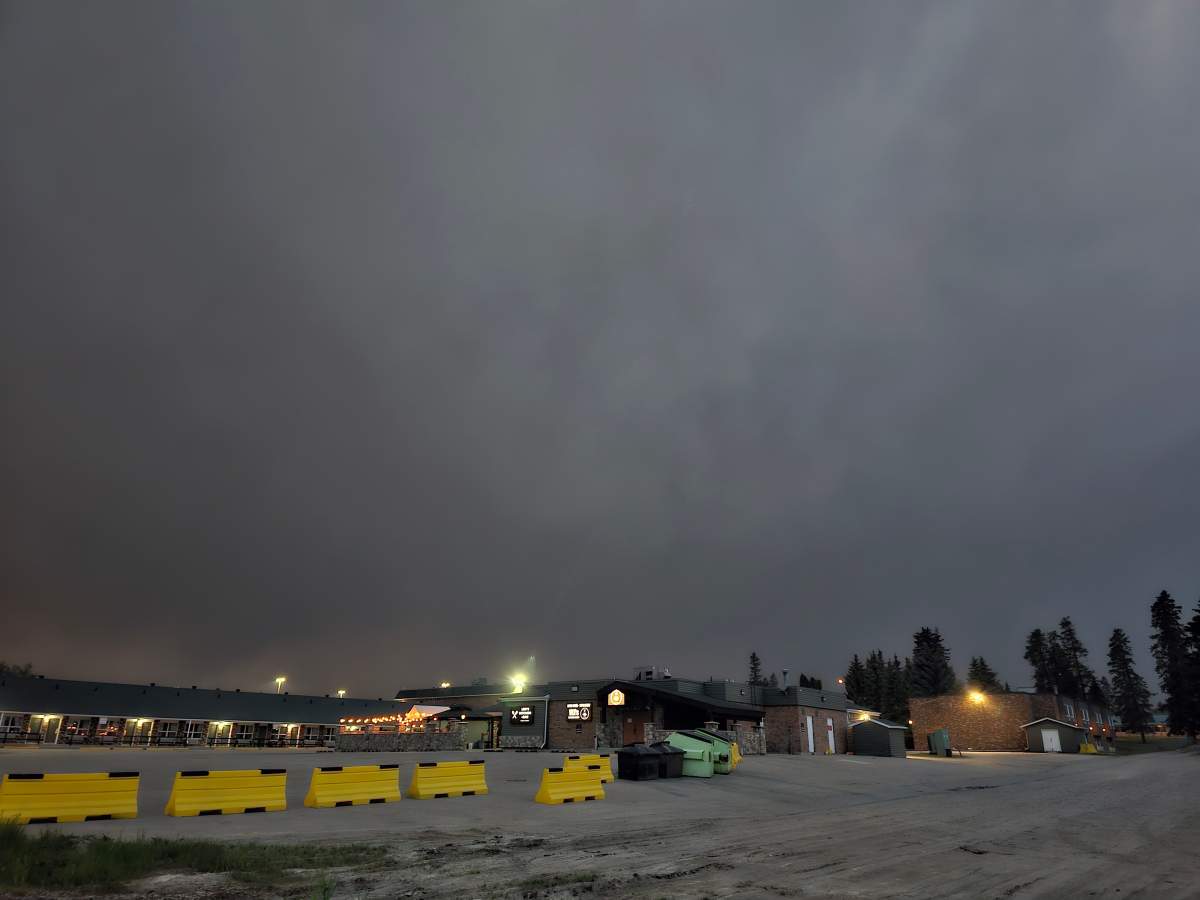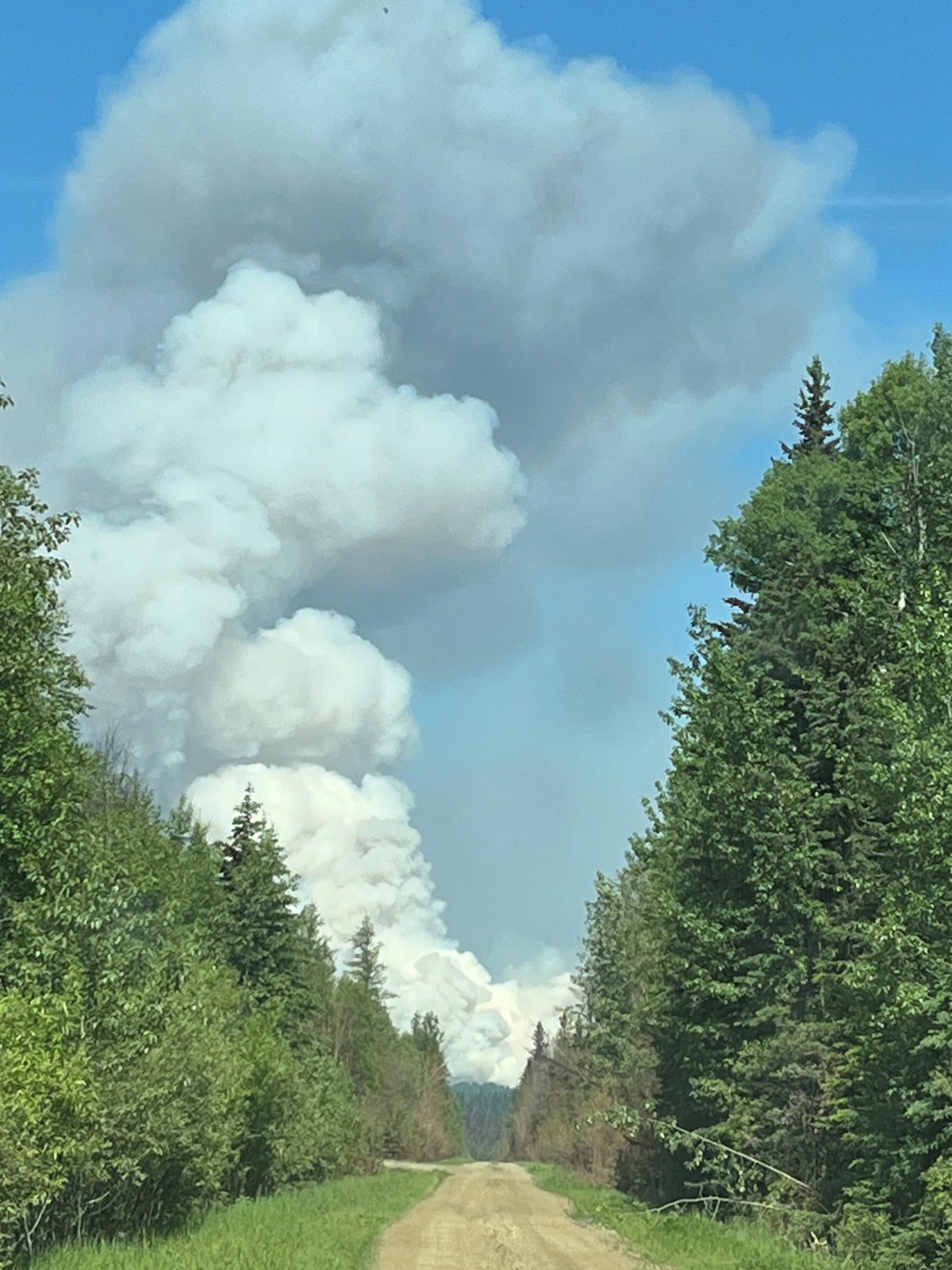After a cool-weather reprieve, wildfire conditions west of Edmonton have become extreme again.

On Friday night, an evacuation order was issued for the town of Edson and much of Yellowhead County.
An 11 p.m. update from the Town of Edson said crews were seeing live embers and fire in Willmore Park, located about five kilometres south of town.
“The fire has crossed the (McLeod) River. If you haven’t evacuated yet, now is the time,” the town said.
“Emergency crews are taxed with fire operations and will not be able to respond if you require assistance.”
Edson Mayor Kevin Zahara posted a video update to Facebook just after midnight Saturday, saying the situation deteriorated throughout the day.
“(Saturday) is not going to be better with more extreme fire behaviour expected,” he said, adding the fire was changing rapidly.
“Please look out for one another. The situation is very serious… Things can be replaced, people cannot.”
A late evening update from Alberta Wildfire said the west side of the fire grew by nearly 21 kilometres Friday to the west and northwest.
The west side of the fire is burning in predominantly spruce trees, which the province said under these extreme conditions spreads upwards of 35 metres per minute.
“Overnight relative humidities are not expected to reduce significantly however the rate of spread will diminish as temperature decreases.”
An Alberta Emergency Alert issued around 6:30 p.m. said due to increased fire activity, flames were becoming increasingly unpredictable.
The fires are moving closer to more populated areas, including Edson, which has a population of about 8,000 people.
“Fires have jumped fire guards. There could be impacts to roads and highways as the fire crosses blocking off points of egress for evacuation,” the emergency alert said.
Yellowhead County said the western boundary of evacuation zone is Range Road 200, the northern boundary is Township Road 570 to Range Road 160, then north to Township Road 580 east to Highway 751 and south to Township Road 520.
It’s an approximate 50-kilometre stretch of land that includes the town of Edson.
“So in layman’s terms, everything between Marlboro and the Nojack Road for Yellowhead County residents is in the evacuation zone,” said Yellowhead County CAO Luc Mercier in a video update Friday night.
Just before 11 p.m., another emergency alert said the wildfire has crossed Highway 47 south of Marlboro and is moving west.
Alberta Wildfire said operational staff confirmed the active flame front of the west flank had grown beyond and crossed the highway.
That evacuation area is Highway 47 west to Medicine Lodge and south of Highway 16 to Township 520. Highway 47 is closed except for local evacuation traffic.
All evacuees are being told to head east, where a reception centre has reopened at the Edmonton Expo Centre (7300 116 Ave.)
A convoy of vehicles could be seen driving east on the Yellowhead Friday night as thick smoke cloaked the air and crown fires were visible from the highway.
Zahara said the Edson Hospital was being evacuated all evening but as of midnight, he wasn’t sure if that process had finished.
The county said Hinton currently has a water restriction in effect, so many services will be unavailable and water supply for campers and RVs will likely be impacted.
Many industry workers are in Hinton and finding hotels and campsites will likely prove challenging, the county said, which is why people are being told to go towards Edmonton.
The leaders of the town and county put out a video update Friday night, urging people to get out just in case the fires grow large enough to block the highways.
“Well, we were certainly hoping that we wouldn’t get back to this point, although we’ve known for the last few weeks that it could possibly happen,” Williams said.
“With the temperatures as high as they are, the humidity is low as it is — this is just the perfect storm for these fires.”

Get daily National news
Later in the evening, Global News spoke with Williams, when he reiterated no one wants to flee again on a Friday night, as the community did back on May 5 (and was allowed to return May 8) but it’s necessary.
“It’s tough on the residents, it’s tough on our staff, it’s tough on our firefighters. We just need an end to this. We don’t see an end in sight right now.”
There are several forest fires in the area that are all part of the Pembina Wildfire Complex, and one of those — EWF031, earlier located about 14 kilometres southeast of Edson — grew rapidly and dangerously Friday, putting Edson at risk.

That fire broke out more than month ago north of the Brazeau Dam because of a lightning strike and in the weeks since has scorched more than 130,762 hectares of land.
In a late afternoon update, Alberta Wildfire said fire behaviour on EWF031 increased significantly as a result of steady and sustained winds from the southeast, pushing the fire in a northwest direction towards town.
Alberta Wildfire said very extreme fire behaviour is being seen: “Firefighters are observing crown fire, meaning that the wildfire is burning in the tree tops.”
(Scroll down for more details on the wildfire.)
“Fire 31, as everyone has been familiar with, I’m sure has taken a serious turn for us and is heading for the community,” said Edson CAO Christine Beveridge.
She said if people choose to disobey the order and stay behind, there will be no medical or fire assistance available to help people if they need it.
Mercier noted it isn’t just Edson affected by Fire 31 — he said the Nojack, Carrot Creek and Marlborough areas are also at risk.
“Because that fire is so much out of control this afternoon, some of the forestry crews have had to back off that fire,” Mercier said.
“They can’t fight it.”
There’s another fire of note in Yellowhead County, north of Peers near Shiningbank Lake. Rural homes in that area were told to evacuate earlier this week as the fire moved south towards Peers and the Yellowhead.
“That fire has expanded exponentially again this afternoon and has posed a serious concern where the crews cannot guarantee our residents safety, nor can we guarantee egress out Highway 32,” Mercier said.
There are fears the Shinkingbank fire will threatening Highway 16 — the main east-west route in the area — and Highway 32.
“The next 36 hours are paramount with the winds coming forward and how these fires will directly affect our residents.”
Mercier said four other fires started Friday in Yellowhead County, about 180 kilometres west of Edmonton.
All residents who have not been evacuated must be prepared to evacuate quickly if the situation worsens, Yellowhead County said.
“So, again, we will plead for everybody to evacuate the evacuated zones and anybody outside of those zones, please be ready to to go within 30 minutes,” Yellowhead County Mayor Wade Williams said.
Bussing will be available from multiple locations in the town and county.
Yellowhead County collection points:
- Marlboro Community Hall, pickup at 7 p.m. and 9 p.m.
- Peers Multiplex, picked up as buses go through to Edmonton
- Niton Green Grove Pool, picked up as buses go through to Edmonton
Town of Edson collection points (pick up from 7 p.m. to 9:30 p.m.):
- Mary Bergeron School
- Westhaven School
- Griffiths Park Centre
- Glenwood Park
- Hillendale Phase 2 Park
All buses congregate at the Edson Leisure Centre for transport to the Edmonton reception centre.
People in the nearby Woodlands County were also told Friday night to be on alert to evacuate.
Extreme wildfire activity in Yellowhead County
Alberta Wildfire said in addition to crown fires, EWF-031 wildfire is producing long-range spotting and independent spot fire. Firefighting under these conditions is extremely dangerous, the province said.
This is the latest from Alberta Wildfire, as of 10 p.m. Friday:
“Today on the Pembina Complex, fire behaviour on EWF031 increased significantly as a result of steady and sustained winds from the southeast, pushing the fire in a northwest direction. Rank 6 fire behaviour is being observed, meaning an organized crown fire front with long-range spotting and independent spot fire growth. Fire observed on the north and west flank was displaying organized flame front up into tree canopies. Firefighting under these conditions is extremely dangerous and crews were pulled from the line in multiple areas due to safety concerns.
Activity along the north flank was extreme today and is expected to continue tomorrow. Significant growth has occurred due to excursions that have crossed guard in three different locations along the north flank. The most northern finger of the north flank is just south of the McLeod river. Heavy equipment night operations have commenced this evening and will continue throughout the night to build containment line along a pre-existing fuel break.
Today, a unit crew from Australia arrived on-site and this evening they will be working through the night in the community of Ansell to apply structure protection apparatuses.
The west side of the fire grew by nearly 21 kilometres (Friday) to the west and to the northwest. Around 1900 this evening the west flank of the fire crossed the Sundance Road contingency line, just east of Erith River. As of 2200, operational staff have confirmed that the active flame front of the west flank has grown beyond and crossed Highway 47. This area of the fire is burning in predominantly spruce, which under these extreme conditions spreads upwards of 35 metres per minute. Overnight relative humidities are not expected to reduce significantly however the rate of spread will diminish as temperature decreases.
On the east side of the fire, a number of excursions have occurred varying in 100 ha each. Fire behaviour is very active all the way along this flank of the fire which continues to challenge crews.
On the southeast corner, an excursion occurred that is approximately 50 ha and has crossed the Elk River Road. This area is just north of the Brazeau Reservoir.
Tomorrow, the biggest anticipated challenge for personnel will be reduced visibility in the surrounding area, as well as the anticipated wind shift expected tomorrow evening around 1900. The cold front is anticipated to bring sustained extreme wildfire behaviour driven by erratic and strong winds from the northwest to the west. This wind shift will likely challenge containment lines along the east flank.
Resources will continue to be reassigned to areas of the fire where they can safely work. Crews are unable to work in areas that are displaying organized flames fronts due to significant safety risk.”
There are 238 firefighters and support staff working on the Pembina Complex. There are 65 pieces of heavy equipment and 21 helicopters assigned to the fires.
A large column of smoke being produced by EWF035, the wildfire near Shiningbank Lake in Yellowhead County, Alta. on Friday, June 9, 2023.On Thursday, a 19,567-hectare wildfire near Shiningbank Lake that’s been burning for more than a month in Yellowhead County grew, prompting an evacuation order for half a dozen properties near the McLeod River.
Earlier this week, the county and province went around and set up sprinklers on many of the rural properties close to the fire as a precautionary measure.
That evacuation order was expanded later in the evening to include residents south of Township 554 to the CN Rail Line between Highway 32 to Range Rd 134.
Evacuees were asked to register with the reception centre set up at the Peers Multiplex.

Alberta Wildfire said there continued to be high fire activity on that fire Friday. It’s part of the Deep Creek Complex, which has 110 firefighters, six helicopters, 40 pieces of heavy equipment and 36 overhead staff working on it.
Alberta Wildfire said in addition to its own dedicated crews, the complex is also being attacked by firefighters from Prince Edward Island, B.C., the United States, Australia and South Africa.
An unprecedented start to the wildfire season led Alberta to bring in a provincewide state of emergency on May 6. At one point, about 29,000 people were out of their homes in various communities.
The state of emergency was lifted last week.
Alberta currently has approximately 2,900 personnel working on wildfires across the province.
That includes support from across Canada, the United States, Australia, New Zealand and South Africa, as well as the Canadian Armed Forces.
— With files from The Canadian Press












Comments